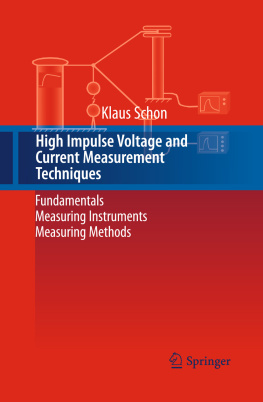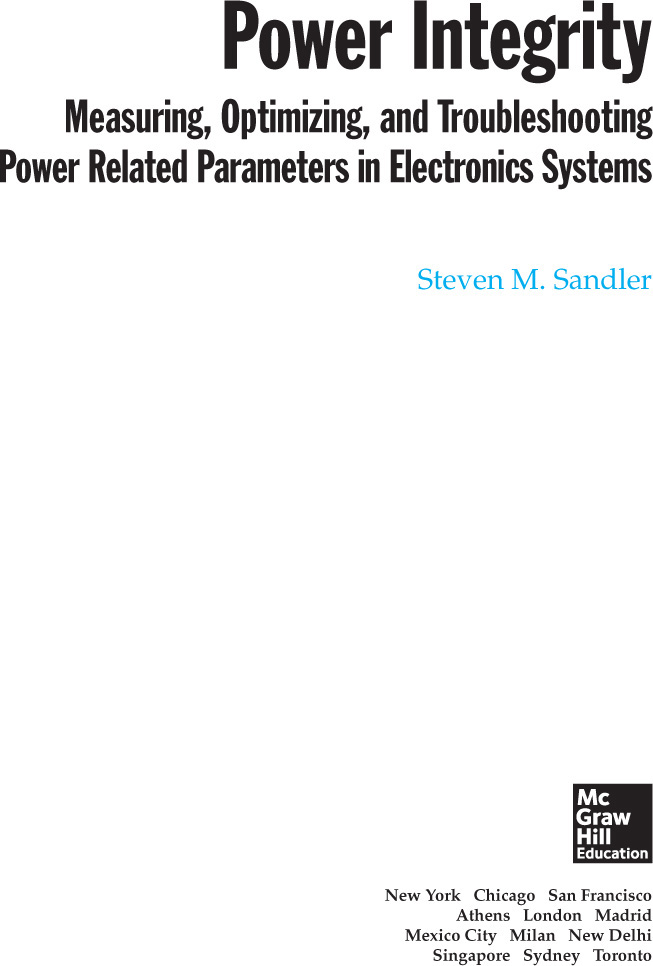About the Author
Steven M. Sandler has been involved in high reliability electronics for nearly 40 years. He is the author of numerous articles relating to power integrity and distributed systems. He is also the author of SMPS Simulation with SPICE 3, Switch-Mode Power Supply Simulation: Designing with SPICE 3, and the co-author of SPICE Circuit Handbook, all available from McGraw-Hill. Mr. Sandler lives in Phoenix, Arizona with his wife.
Copyright 2014 by McGraw-Hill Education. All rights reserved. Except as permitted under the United States Copyright Act of 1976, no part of this publication may be reproduced or distributed in any form or by any means, or stored in a data base or retrieval system, without the prior written permission of the publisher.
ISBN: 978-0-07-183100-0
MHID: 0-07-183100-2
The material in this eBook also appears in the print version of this title: ISBN: 978-0-07-183099-7, MHID: 0-07-183099-5.
eBook conversion by codeMantra
Version 1.0
All trademarks are trademarks of their respective owners. Rather than put a trademark symbol after every occurrence of a trademarked name, we use names in an editorial fashion only, and to the benefit of the trademark owner, with no intention of infringement of the trademark. Where such designations appear in this book, they have been printed with initial caps.
McGraw-Hill Education eBooks are available at special quantity discounts to use as premiums and sales promotions or for use in corporate training programs. To contact a representative, please visit the Contact Us page at www.mhprofessional.com.
Information contained in this work has been obtained by McGraw-Hill Education from sources believed to be reliable. However, neither McGraw-Hill Education nor its authors guarantee the accuracy or completeness of any information published herein, and neither McGraw-Hill Education nor its authors shall be responsible for any errors, omissions, or damages arising out of use of this information. This work is published with the understanding that McGraw-Hill Education and its authors are supplying information but are not attempting to render engineering or other professional services. If such services are required, the assistance of an appropriate professional should be sought.
TERMS OF USE
This is a copyrighted work and McGraw-Hill Education and its licensors reserve all rights in and to the work. Use of this work is subject to these terms. Except as permitted under the Copyright Act of 1976 and the right to store and retrieve one copy of the work, you may not decompile, disassemble, reverse engineer, reproduce, modify, create derivative works based upon, transmit, distribute, disseminate, sell, publish or sublicense the work or any part of it without McGraw-Hill Educations prior consent. You may use the work for your own noncommercial and personal use; any other use of the work is strictly prohibited. Your right to use the work may be terminated if you fail to comply with these terms.
THE WORK IS PROVIDED AS IS. MCGRAW-HILL EDUCATION AND ITS LICENSORS MAKE NO GUARANTEES OR WARRANTIES AS TO THE ACCURACY, ADEQUACY OR COMPLETENESS OF OR RESULTS TO BE OBTAINED FROM USING THE WORK, INCLUDING ANY INFORMATION THAT CAN BE ACCESSED THROUGH THE WORK VIA HYPERLINK OR OTHERWISE, AND EXPRESSLY DISCLAIM ANY WARRANTY, EXPRESS OR IMPLIED, INCLUDING BUT NOT LIMITED TO IMPLIED WARRANTIES OF MERCHANTABILITY OR FITNESS FOR A PARTICULAR PURPOSE. McGraw-Hill Education and its licensors do not warrant or guarantee that the functions contained in the work will meet your requirements or that its operation will be uninterrupted or error free. Neither McGraw-Hill Education nor its licensors shall be liable to you or anyone else for any inaccuracy, error or omission, regardless of cause, in the work or for any damages resulting therefrom. McGraw-Hill Education has no responsibility for the content of any information accessed through the work. Under no circumstances shall McGraw-Hill Education and/or its licensors be liable for any indirect, incidental, special, punitive, consequential or similar damages that result from the use of or inability to use the work, even if any of them has been advised of the possibility of such damages. This limitation of liability shall apply to any claim or cause whatsoever whether such claim or cause arises in contract, tort or otherwise.
This book is dedicated to my wife, Susan. She had the very difficult job of
keeping my stress level down and my outlook up. She sacrificed the many
hours I spent in my man cave making measurements rather than
spending time with her. When I (frequently) whined about how much
work writing this book was, she never said I told you so, but gave me
the pep talk I needed to keep me motivated. Sweetheart, I love you.
Contents
Acknowledgments
W riting this book was a major undertaking. Of course writing any book is a lot of work, but the vast range of instruments necessary to perform the measurements and finding ideal examples to measure stepped it up a bit. Many of the concepts in this book may be new and so the information had to be presented very clearly and concisely. This effort required a lot of support from many individuals and companies. Without this support, I would never have been able to complete this book. I also had a record number of peer reviewers for this book. I am forever grateful to the following individuals and companies and apologize profusely in the event I left anyone out.
I want to thank my editor, Michael McCabe, and all of the folks at McGraw-Hill for giving me the opportunity to write another book on a subject that has received little attention. A special thank you for allowing me luxury of presenting this book in color. Thanks to Kritika Kaushik, the project manager for the book. She had the difficult job of making this book happen.
Thanks to my long term friend and business partner, Charles Hymowitz, Vice President of Sales and Marketing for Picotest, and CEO of AEi Systems. He read every page, edited, commented, and offered many helpful suggestions to make this a better book. Thank you does not seem to cover it, but thanks.
Bernhard Baumgartner, Florian Hmmerle, and Wolfgang Schenk of OMICRON Lab for their constant support, for including the noninvasive measurement in their instrument and for being great friends in addition to sales partners. Thanks for the support and the many helpful comments and suggestions.
Mark Roberts, Stacy Hoffacker, Mike Mende, Amy Higgins, and Tom Lenihan from Tektronix were always ready and willing to help, whether it was to discuss equipment, answer questions, or arrange the shipment of loaner instruments to and from my lab. They also offered some comments and suggestions.
David Tanaka, Yasuhiro Mori, Eileen Meenan, and Hiroshi Kanda from Agilent Technologies for the tremendous knowledge they possess regarding their instruments and their willingness to share some of it with me. I also thank them for arranging the shipment of loaner instruments in and out of my lab.
Dan Burtraw, David Rishavy, and Mike Schnecker from Rohde-Schwarz for arranging the loan of their RTO1044 oscilloscope, for answering the many questions I asked, and for providing helpful comments and suggestions helping to make this a better book.
Bob Hahnke, Steve Murphy, Stephen Mueller, and Kathleen Woods from Teledyne Lecroy for their support of demo equipment and for the helpful comments they provided.
Hawk Shang of PICOTEST Corp for his generous support of our projects, for making excellent general purpose test equipment, and for manufacturing the Picotest signal injectors. Hawk, thank you for all that you do.
Next page













